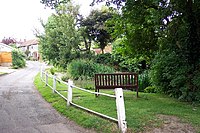St Margaret's at Cliffe
| St Margaret's at Cliffe | |
|---|---|
 Chapel Lane, St Margaret's-at-Cliffe |
|
| St Margaret's at Cliffe shown within Kent | |
| Population | 2,499 (2011 Census including Westcliffe) |
| OS grid reference | TR3544 |
| District | |
| Shire county | |
| Region | |
| Country | England |
| Sovereign state | United Kingdom |
| Post town | Dover |
| Postcode district | CT15 6 |
| Police | Kent |
| Fire | Kent |
| Ambulance | South East Coast |
| EU Parliament | South East England |
St. Margaret's at Cliffe is a three-part village situated just off the coast road between Deal and Dover in Kent, England. The heart of the village is about 3/4 mile (1 km) from the sea with the residential area of Nelson Park further inland and St Margaret's Bay situated along and below the cliffs north of South Foreland.
Channel swimmers and submarine telephone cables start from St Margaret's Bay. At the north end of the bay is Leathercote Point (sometimes spelt Leathercoat Point or Lethercote Point), where there is a war memorial commemorating the Dover Patrol. According to the International Hydrographic Organization, Leathercote Point marks the western end of the line which defines the divide between the North Sea and the English Channel, the opposite end being at the Walde Lighthouse near Calais.
During the Second World War most of the population were moved out and guns with their attendant military personnel were moved in. Most of the guns were anti-aircraft but there were heavier pieces intended to prevent German shipping from travelling along the French coast. There were two 15 in (380 mm) guns called "Jane" and "Clem" and there were also the two famous ex-Navy BL 14 inch Mk VII naval guns called "Winnie" and "Pooh". They originally came from the battleship HMS King George V. On one occasion when Winston Churchill was visiting, it is rumoured that "Winnie" was fired and the officer-in-charge saluted and reported: "A direct hit, Sir". "On what ?" enquired Winston, "Er – France, Sir". There was a wooden dummy of "Pooh" but it obviously did not fool the Germans as legend has it that they dropped a wooden bomb.
The parish church suffered a direct hit from German guns located in Calais but the only damage was the destruction of a window dedicated to John Knott, lighthouse keeper of South Foreland Lighthouse.
...
Wikipedia

